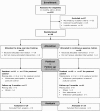The effect of continuous passive motion and sling exercise training on clinical and functional outcomes following total knee arthroplasty: a randomized active-controlled clinical study
- PMID: 24886619
- PMCID: PMC4024275
- DOI: 10.1186/1477-7525-12-68
The effect of continuous passive motion and sling exercise training on clinical and functional outcomes following total knee arthroplasty: a randomized active-controlled clinical study
Abstract
Background: The parallel-group randomized active-controlled clinical study was conducted to compare the effectiveness of two in-hospital range of motion (ROM) exercise programs following total knee arthroplasty (TKA). Continuous passive motion (CPM) is frequently used to increase ROM and improve postoperative recovery despite little conclusive scientific evidence. In contrast, a new active sling-based ROM therapy requires the activation of the knee joint muscles and dynamic joint stabilization. It was hypothesized that higher demands on muscle strength and muscle coordination during sling exercise training (ST) might be advantageous for early recovery following TKA.
Methods: A total of 125 patients undergoing primary TKA were assessed for eligibility. Thirty-eight patients were randomly assigned to receive ST or CPM (control intervention) during hospital stay. Patients were assessed before TKA for baseline measurement (pretest), 1 day before discharge (posttest) and 3 months after TKA (follow-up). The passive knee flexion range of motion (pFL) was the primary outcome measure. Secondary outcome measures included active knee flexion range of motion, active and passive knee extension ROM, static postural control, physical activity, pain, length of hospital stay as well as clinical, functional and quality-of-life outcomes (SF-36, HSS and WOMAC scores). Data were analyzed according to the intention-to-treat principle. Differences between the groups were tested for significance by the unpaired Student's t test or an analysis of covariance (ANCOVA) adjusted for baseline, weight, sex, age, pain and physical activity.
Results: A between-group difference could be determined at posttest. The pFL was significantly higher by 6.0° (95% CI 0.9 to 11.2°; P = 0.022) in the ST group. No difference between groups in pFL was documented at follow-up. Furthermore, no significant differences could be observed for any secondary outcome measure at posttest and follow-up.
Conclusions: ST seems to have a clinically relevant beneficial short-term effect on pFL compared to CPM. The results support the implementation of ST in rehabilitation programs following TKA.
Level of evidence: Therapy, level 2b.
Figures



Similar articles
-
Effects of lower-limb active resistance exercise on mobility, physical function, knee strength and pain intensity in patients with total knee arthroplasty: a systematic review and meta-analysis.BMC Musculoskelet Disord. 2024 Sep 12;25(1):730. doi: 10.1186/s12891-024-07845-9. BMC Musculoskelet Disord. 2024. PMID: 39267026 Free PMC article.
-
Effectiveness of continuous passive motion and conventional physical therapy after total knee arthroplasty: a randomized clinical trial.Phys Ther. 2006 Feb;86(2):174-85. Phys Ther. 2006. PMID: 16445331 Clinical Trial.
-
Use of drop and dangle rehabilitation protocol to increase knee flexion following total knee arthroplasty: a comparison with continuous passive motion machine.J Med Assoc Thai. 2014 Sep;97 Suppl 9:S16-22. J Med Assoc Thai. 2014. PMID: 25365884
-
Exercise combined with continuous passive motion or slider board therapy compared with exercise only: a randomized controlled trial of patients following total knee arthroplasty.Phys Ther. 2001 Apr;81(4):1029-37. Phys Ther. 2001. PMID: 11296803 Clinical Trial.
-
Continuous Passive Motion After Total Knee Arthroplasty: A Systematic Review and Meta-analysis of Associated Effects on Clinical Outcomes.Arch Phys Med Rehabil. 2019 Sep;100(9):1763-1778. doi: 10.1016/j.apmr.2019.02.001. Epub 2019 Mar 2. Arch Phys Med Rehabil. 2019. PMID: 30831093
Cited by
-
Effect of different postoperative flexion regimes on the outcomes of total knee arthroplasty: randomized controlled trial.Knee Surg Sports Traumatol Arthrosc. 2017 Sep;25(9):2972-2977. doi: 10.1007/s00167-016-4119-9. Epub 2016 Apr 7. Knee Surg Sports Traumatol Arthrosc. 2017. PMID: 27056697 Clinical Trial.
-
Effect of suspension training on neuromuscular function, postural control, and knee kinematics in anterior cruciate ligament reconstruction patients.World J Clin Cases. 2021 Apr 6;9(10):2247-2258. doi: 10.12998/wjcc.v9.i10.2247. World J Clin Cases. 2021. PMID: 33869600 Free PMC article.
-
Effects of lower-limb active resistance exercise on mobility, physical function, knee strength and pain intensity in patients with total knee arthroplasty: a systematic review and meta-analysis.BMC Musculoskelet Disord. 2024 Sep 12;25(1):730. doi: 10.1186/s12891-024-07845-9. BMC Musculoskelet Disord. 2024. PMID: 39267026 Free PMC article.
-
Evaluation of Safety and Efficacy of ReHub in Patients Who Underwent Primary Total Knee Arthroplasty: Study Protocol for a Randomized Controlled Trial.Int J Surg Protoc. 2021 Apr 19;25(1):34-41. doi: 10.29337/ijsp.138. Int J Surg Protoc. 2021. PMID: 34013143 Free PMC article.
-
Rehabilitation protocols following total knee arthroplasty: a review of study designs and outcome measures.Ann Transl Med. 2019 Oct;7(Suppl 7):S255. doi: 10.21037/atm.2019.08.15. Ann Transl Med. 2019. PMID: 31728379 Free PMC article. Review.
References
-
- Grella RJ. Continuous passive motion following total knee arthroplasty: a useful adjunct to early mobilisation? Phys Ther Rev. 2008;13:269–279. doi: 10.1179/174328808X309197. - DOI
-
- Viswanathan P, Kidd M. Effect of continuous passive motion following total knee arhtroplasty on knee range of motion and function: a systematic review. NZ J Physiother. 2010;38:14–22.
-
- Milne S, Brosseau L, Robinson V, Noel MJ, Davis J, Drouin H, Wells G, Tugwell P. Continuous passive motion following total knee arthroplasty. Cochrane Database Syst Rev. 2003;2 CD004260. - PubMed
-
- Lenssen AF, De Bie RA, Bulstra SK, van Steyn MJA. Continuous passive motion (CPM) in rehabilitation following total knee arthroplasty: a randomized controlled trial. Phys Ther Rev. 2003;8:123–129. doi: 10.1179/108331903225003019. - DOI
Publication types
MeSH terms
LinkOut - more resources
Full Text Sources
Other Literature Sources
Medical
Research Materials

